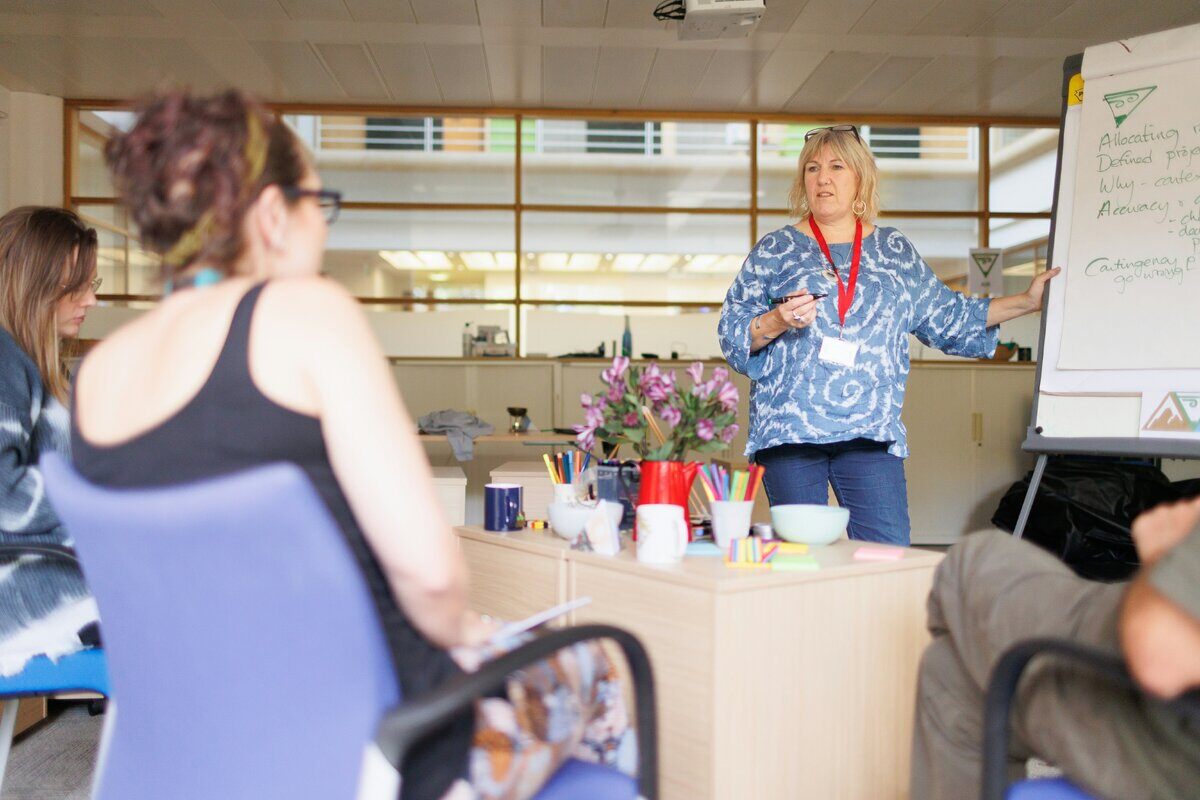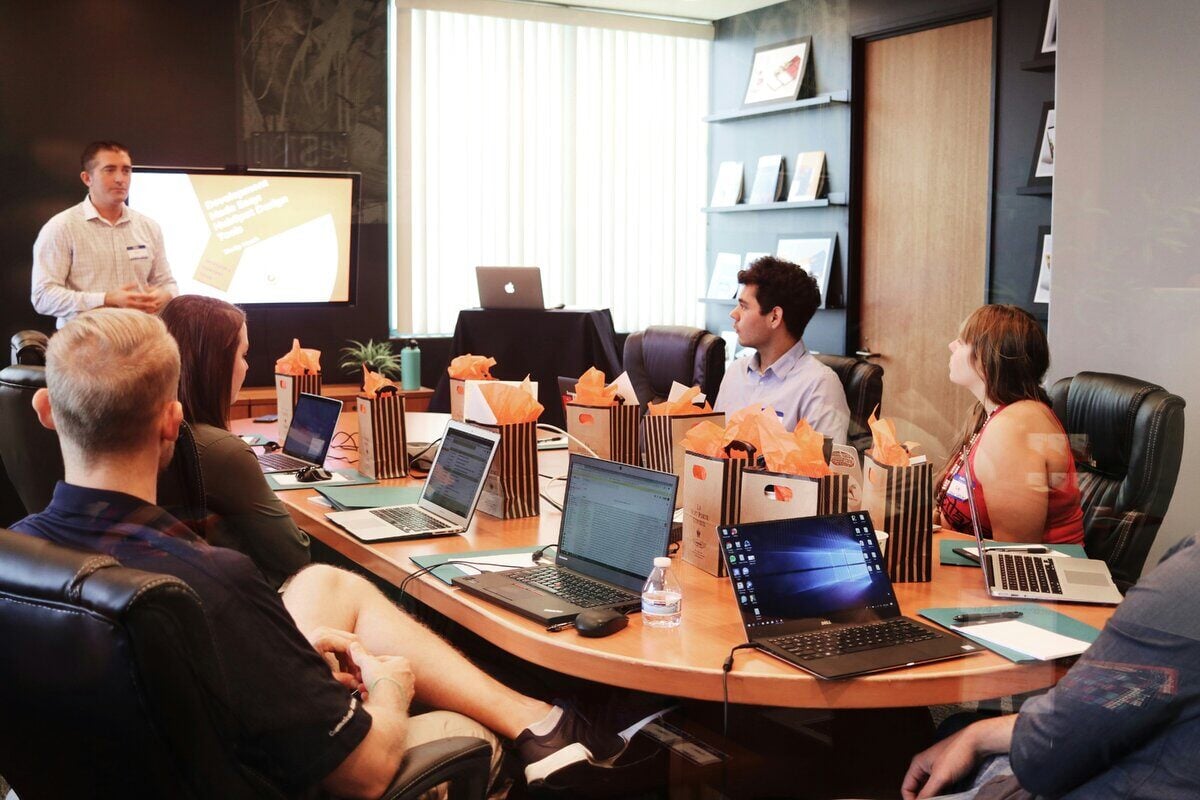
6 Different Models Of Blended Learning In The Workplace [With Examples]
Information technology has changed nearly every aspect of modern life. It has changed the ways companies do business, with services and options much closer to the end user.
It has changed corporate culture with more people working remotely more often.
It has changed the ways colleges and universities impart knowledge.
The biggest example of this is the access returning adult students have to remote learning opportunities.
It has also revolutionized medicine, with remote consultations becoming more and more common, reducing the cost of medical advice drastically.
Naturally, these are just a few examples of the ways information technology has changed our lives.
When it comes to the ways employers train their employees and craft corporate culture, the transformation is no less drastic.
Today, employers are turning to a model of teaching and training known as blended learning.
This teaching modality leverages technology in order to expand the ways and times employees can learn.
It makes room for persons with different learning preferences to learn in a way that is more amenable to the absorption of information.
But most importantly, it has extended the power of workplace training in multiple ways.
Here, we will discuss what blended learning is, how it is used, and share some examples to help you understand how it can be used to great effect in your workplace.
What Is Blended Learning?
As the name implies, blended learning is about adding the advantages of modern technology and blending them with the advantages of traditional learning, teaching methods, and tools.
In reality, blended learning has been with us for hundreds of years.
Consider, for example, the fact that students in any type of school have always been able to take notes and review them in their own time.
The same goes for textbooks.
These companions to lectures and classroom discussions go home with the student and can be read and reread any time the student has time.
In more recent times, students will bring audio recording devices and listen to lectures and discussions again and again at their leisure.
Blended learning is sometimes referred to as "hybrid learning."
This, too, suggests the fact that we are adding digital means and methods of sharing information to the classroom experience and using them to enhance the opportunity to learn, as well as the quality of learning.
The difference with blended learning is that we are referring to computer and internet-based technologies to extend the time and ways in which students learn.
These materials can be videos or audio recordings.
They can be games, activities, and much more.
They can even be forums and social media pages where the learner can engage with the ideas of other students on the topic.
Blended learning special in at least two important ways.
First, it extends the amount of time that students can engage with the material.
They can learn when they are ready to learn in their own time.
They can choose the time and place to review or engage with the material for the best results.
One of the coolest benefits, which has been with us for as long as audio recordings have been around, is the student can listen to audio recordings at the gym, while washing dishes, while driving, and more.
This not only enhances the quality and opportunity for learning, but it enhances the value of those other activities, as well.
The second major benefit of blended learning is even more important.
Blended learning has the potential to translate the information you are trying to impart into any other form of stimulus.
As we all know, some people learn best visually.
Some learn best by listening and some by reading.
Others learn best by discussing the learning material.
Many others learn best through hands-on interaction.
These are the most common ways some people prefer to learn and learn best.
Blended learning makes all of the different modes of learning potentially available to the student.
If, for instance, you have 10 audio learners and one tactile learner in your classroom, the minority learner is likely to get left behind.
With blended learning, this becomes a non-issue.
The thing that is most important is recognizing different learning types.
Naturally, that can be a challenge.
But, once you figure out what learning types you have in your group, you can accommodate them all.
Of course, covering the major learning types is no problem.
We can do this by simply offering video material that students can watch and/or listen to on their own time.
How Is Blended Learning Used In The Workplace?
During the COVID-19 pandemic, at a time when many workplaces and classrooms were inaccessible, blended learning became the norm.
The same is true about much of what we do in our places of work.
Digital information tech had to be used in new and innovative ways.
But more importantly, it had to be used in new and innovative combinations of ways.
While blended learning has been used in schools and universities for at least 20 years, the ways it can and should be used in the workplace are even more numerous.
This is due to the fact that places of work are more diverse in terms of the information that is relevant and the skills and learning modes that are applicable.
Here are just a few of the primary ways blended learning is often used in the workplace:
Online Learning & In-Person, Hands-On Practice
When using this strategy, the employees will perform most of the learning via the internet and then convene later to engage in hands-on practice.
For example, employees in a customer service department might take a course spread out over a week's time.
You might then conclude the lessons by engaging in simulated live calls.
Then, at that time, the group leader can be present to offer suggestions and criticisms.
Team Goals + Lecture Training
In this format, lecture training may be completed either online or offline.
The in-person flip side of this method would be goal-setting as a team.
The team's goals should be directly connected to the training.
This will encourage your employees to use what they have learned and to test their new skills while supporting each another as they continue to integrate new ideas and strategies.
Online Practice + In-Person Class Time
In this workplace learning format, your employees will spend a given amount of time in classroom sessions.
Later, they will test what they have learned in an online training session.
Follow-ups are then conducted in person to give your team the opportunity to ask any questions they may have.
What Are The Different Models Of Blended Learning?
While the above arrangements are somewhat informal, even ad-hoc, there are more widely accepted models of blended learning out there for us to emulate.
The examples described in this section have been developed in workplaces, researched academically, and are generally considered to be the most tried, true, and proven models.
The most important thing is to make the teaching and tools work for your team, for the skills to be learned, and for the needs of your industry.
That is what we should take from the modes of use described above.
The formalism of the following methods can be seen as a guide rail.
What matters most is finding a way to use blended learning that works for your workforce and your business.
Face-to-Face Driven Learning
Most similar to a traditional classroom setting, this model is driven by lectures and discussions given in person in a central setting.
Materials may be used in the classroom and outside of it.
These may be texts, online articles, videos, or other interactive tools.
But, the focus will always be on lectures and discussions given and shared in person in a shared environment.
It's worth noting that any method that leans heavily on one mode of teaching should be used when all or a vast majority of the learners are determined to be disposed to learn best in that way.
There may be other reasons to use this type of method, but respect for preferred learning styles will always be directly correlated to the success of your training efforts.
The Rotation Model
In the rotation model, students will move from one station to the next in turns, or they will move from one blended learning modality to the next.
In a more traditional classroom or learning lab setting, these would be like stations in booths or tables.
In a blended setting, it might be that the students take turns consuming a set of videos, interacting with online activities, and/or completing hands-on challenges.
The Flex Model
With this model, the majority of the blended learning will be completed online.
Like in the previous model, we will have students engaged in separate sessions while in the same classroom. They may move from one to the next, but the majority of the training is designed to be done independently.
The purpose of retaining the classroom time with the instructor is to give the students the opportunity to have their questions answered and to get one-on-one interaction with the instructor.
But, one-on-one instruction is largely voluntary.
Here, instruction is meant to support the blended activities and not the other way around.
The Online Lab Model
This model is similar to the flex model, except that there is a greater emphasis on teacher-led instruction.
The primary purpose of this method is as a means of coping with limited classroom space, time, or other availability issues.
An online lab will be the platform where students perform most of their work, complete research, and carry out assigned activities.
It's a way to use the power of information technology to make up for other aspects of the learning experience that may be lacking.
But, it's also a good model to use when your learners are independently-minded people, as is often the case with professionals.
The Self-Blending Model
A traditional classroom as we find it today might be considered a self-blended learning environment.
That is to say, it is not uncommon for students to forego class time for online learning.
This model can be deployed with great effect in professional settings where compelling your team to be in a classroom at a given time is not acceptable in the corporate culture.
The Online-Driven Model
It is likely that most groups will prefer this model today.
The online-driven model is the opposite of the face-to-face-driven model.
It may or may not incorporate in-person teaching sessions.
It may rely on an instructor giving available office hours when students can seek them out for clarification.
This model is also a good one to use if classroom time is limited or unavailable.
It is an effective way to deal with limited resources, especially when you are developing new workplace training activities for the first time.
Blended Learning Examples
- Learning management systems: These are the latest blended learning systems. LMS helps you manage course material, curate a library, and automates much of the process. Students engage with the material as directed and in their own time.
- Learning experience platforms: Often mistaken for an LMS, LXPs are more of an online "place" to learn rather than a repository of static learning material. It may incorporate activities, games, videos, and more.
- Team-building activities: TBAs often look like the standard "corporate ropes" course activities where members learn trust. But for our interests, the activities will be geared toward the material with which your business is concerned. A learning lab may describe it best.
- Mentoring: A classic learning method, mentoring within a blended learning model is an excellent way to get the best out of your most promising talent. It's a great way to bring them up to the next level of responsibility.
- Peer-to-peer learning: The more teaching/learning spaces are blended with information tech, the more peer-to-peer learning is needed. It is a result of the decentralizing effect of infotech, and it is a natural result of blended learning.
- Mobile learning: Mobile apps are excellent for the gamification of learning processes, which boosts engagement. It also makes material available even at times and places when a PC is not available or practical.
- Seminars, Webinars, & Podcasts: A classic learning modality for corporate groups, seminars and webinars are the business-class version of the traditional classroom. Seminars may incorporate blended learning material, and a webinar is blended learning material. Podcasts can be seen as a less formal version of a webinar.
- Self-paced learning: The more professional and independently mined your team is, the more self-paced learning is needed. Certain types of learners also naturally fare better with this method.
Conclusion
As we have seen, there are many ways to create and employ a method and type of blended learning.
The type of blended learning you use should depend on the subject matter as well as the needs of your industry and your customers.
It should also be based on the level of independence, professionalism, and preferred learning methods of your students.
At the end of the day, it's not the blending that matters,
It's giving your learners every opportunity to learn in a way that works best for them.
Do you want to talk further about how any of these blended learning models could work for your organization?
Sources






